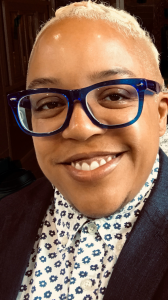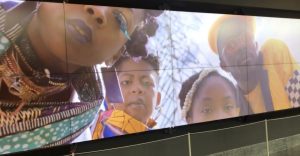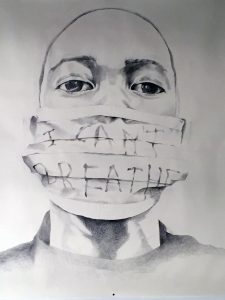Making the revolution irresistible

Portrait of QueenTite Opaleke, 2016, graphite on paper by Syrus Marcus Ware
 Syrus Marcus Ware is a visual artist, community activist, scholar and educator. This September, he’ll be joining McMaster’s School of the Arts, teaching courses in theatre and film studies and working with SOTA faculty to develop the iArts program. Here, we learn a little more about his work.
Syrus Marcus Ware is a visual artist, community activist, scholar and educator. This September, he’ll be joining McMaster’s School of the Arts, teaching courses in theatre and film studies and working with SOTA faculty to develop the iArts program. Here, we learn a little more about his work.
Tell me about yourself
I’m a visual artist, an activist, an educator and a scholar. I’ve been practicing and organizing in Tkaronto [a Mohawk word meaning “the place in the water where the trees are standing,” from which the name for Toronto originated] for about 25 years. I became an artist 25 years ago, around the same time I began organizing.
I am just finishing a PhD at York University in the Faculty of Environmental Studies, and I’m a core team member of Black Lives Matter-Toronto.
Most recently, I was also one of the editors of Until We Are Free: Reflections on Black Lives Matter in Canada, which has spent six weeks on the Canadian bestseller list.

How do your art, activism and teaching intersect? Do they inform each other?
My artist practice is very much rooted in an understanding of the quote from Toni Cade Bambara that says the role of the artist from an oppressed community is to make the revolution irresistible. In fact, the title of my PhD dissertation is Irresistible Revolutions.
My practice is necessarily tied up with activism, and I do try to work using performance, visual practices including drawing and painting, and installation to tell a story that makes the revolution irresistible.
As a teacher, I’m interested in how people learn, and how they take in information. There are lots of different ways people can experience art: touch, sitting and looking, listening to the soundscape, watching a video. It encompasses a lot of different learning modalities.
In my activist practice, I use very creative activisms as part of my approach – so we do large-scale demonstrations that use performance and visual art as part of the practice. I’ve worked with the community collective Blackness Yes! to produce Blockorama, a Black queer arts festival at Pride that drew more than 20,000 people last year. That was a celebratory moment.
My scholarship is really rooted in this idea that to be an artist, to be an activist, to be doing this work, is to be engaging in acts of speculative fiction – for we are necessarily dreaming and imagining in creative ways. My scholarship is tied to understanding and examining Black activist culture and artistic practice.
There are many different areas of activism you’re involved with: Black Lives Matter, trans justice, disability justice, eco justice. Is there a common theme?

I got involved in organizing because I had an understanding that the system could be radically different than it currently is– it was this idea that we all had the right to self-determination. So for me, Mad, Deaf and disability activism, trans justice and trans liberation, and Black liberation struggles are all intimately connected because they’re all trying to achieve a similar goal, which is the self-determination of all people.
I’m exploring ways to imagine a future that hasn’t yet been determined, and working to improve the life chances for folks who are marginalized.
If we’re making a world that is safer for those people, we’re making a world that is safer for everybody.
The struggles that I’ve been involved in are all interconnected – and they ultimately offer us a possibility of imagining another world: a world where trans people get to live long enough to become elders, a world where Black lives mattered and were considered inherently valuable, and a world where disability was expected, anticipated, celebrated and loved for all the magic it can be.
Your works are all very different, using a variety of media and types of performance? Do they have a common thread running through their differences?
All of my projects, whether it’s the activist portrait series, Activist Love Letters, the installation and performance works Ancestors Do You Read Us? and Antarctica, are similar in some ways because they pick up this idea of the sustainability of activists’ struggles, and how we can possibly continue organizing in order to get to a future together.

I’ve been teaching systems change and systems thinking at the Banff Centre for five or six years, and one of the things we study is the panarchy cycle of systems change: this idea that all systems go through a life cycle of growth and expansion, but also of collapse, reorganization and regeneration.
The projects that I’ve been involved in creating are projects that tell a story about a system at a certain period in that life cycle.
In Antarctica, the system has collapsed, and they go to Antarctica in a last-ditch attempt to save humanity. In Ancestors Do You Read Us? a new future has emerged. Activist Love Letters and the activist portrait series takes place in a system that in the middle of a change, where the people who are supporting that change need our love and care.
They’re all very much interconnected.
Can you share a little about what you’ll be doing at McMaster? What are the challenges and opportunities that present themselves when you’re teaching art online?
I’m really looking forward to joining the team at McMaster, and really excited about the opportunities that online teaching provides. I’ve been involved in disability justice communities for decades, and one of the things that we’re known for is early adapters to online spaces – in part because, for many people, going out is just not a possibility in their everyday life because of ableism challenges.
I’ve been able to learn a lot about how to create interactive, responsive, reciprocal learning environments that feature an online component and I’m really excited to be able to experiment and play with that at McMaster. Working online presents an opportunity to increase access for a lot of people.

I’ll be teaching in performance and theatre studies, and I’ll be exploring process, theory and application through online and virtual teaching.
How did you get to where you are? What journey have you taken to be here?
I’ve been in the arts for 25 years. I worked for about 14 years running youth programs at the Art Gallery of Ontario. I worked at the National Arts Centre on a three-year curatorial project exploring diversity in theatre. I’ve been involved in a lot of arts-based institutions, trying to push for some kinds of changes to happen that would make them more accessible and open to a variety of audiences.
I’m excited about the opportunities to bring my performance practice and what I’ve learned in terms of how and why we create what we create to students as they go through their own process of working together.


